Vacuum insulated tube production process
Vacuum insulation tube is a key insulation material used to reduce heat conduction and energy loss in high temperature and high pressure environments. Its production process involves multiple steps, from material preparation to quality inspection of the final product, requiring strict process control and quality management.
1. Material preparation:
Before producing vacuum insulated tubes, materials first need to be carefully selected and prepared. The outer material is usually made of metal or alloy with high strength and high pressure resistance to ensure the stability of the shell. The adsorbent and evaporant inside the vacuum layer also need to choose high-quality materials with good adsorption and evaporation properties.
2. Manufacturing process:
The outer layer manufacturing stage involves sheet metal processing, welding and other processes to form the metal or alloy into the casing of the pipe or equipment. The manufacturing of the vacuum layer requires the use of advanced vacuum packaging technology, including vacuuming, injection of adsorbents and evaporants, etc., to form a stable vacuum environment.
3. Testing and Quality Control:
During the production process, sealing testing is a crucial step to ensure that there is no leakage in the vacuum insulation layer and that the vacuum reaches the design standard. At the same time, the performance is tested, including withstand voltage test, thermal conductivity test, etc., to ensure that the product can meet the requirements in actual applications. Visual inspection is also essential to ensure that the outer surface is smooth and free of cracks or other defects.
4. Assembly and packaging:
After all tests and inspections are passed, the outer layer and vacuum insulation layer are assembled together to form the final vacuum insulated tube product. Final visual inspection and performance testing again ensure the quality of the finished product. Subsequently, packaging work is carried out to ensure that the product is not damaged during transportation and storage.
5. Quality management and certification:
Throughout the production process, the implementation of a quality management system is crucial to ensure that every link meets standards. In addition, products may need to pass relevant certifications, such as ISO certification, to ensure that the products comply with international or industry standards.
6. After-sales service and maintenance:
Once the product is delivered to the customer, providing good after-sales service and technical support is indispensable. At the same time, a regular maintenance plan is developed, including checking the vacuum degree, cleaning the outer surface, etc., to ensure the continued performance of the product.




